The Sack of Balbriggan and British reprisals in Ireland in Autumn 1920
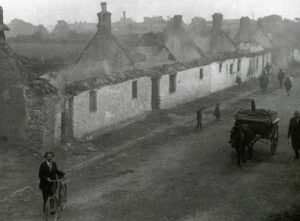
By John Dorney
On the night of September 20-21, 1920, four lorry loads of police, the Royal Irish Constabulary (RIC) and their Auxiliary Division, descended on the small, north county Dublin town of Balbriggan from their depot at Gormanstown and the military air base at Collinstown.
Some of the police were ‘Black and Tans’, military veterans recently recruited from Britain, but others were Irish ‘Old’ RIC men. They were out for revenge.
The previous day, an RIC District Inspector Peter Burke had been shot dead there, and another RIC officer wounded in a public house. It had been an opportunistic attack by local IRA members, as Burke and his brother Michael, also an RIC sergeant, were drinking in a local pub, Smyth’s. After they were spotted, two local IRA Volunteers, Michael Rock and John Denham, who were drinking elsewhere in the town, fetched two revolvers, entered Smyth’s and shot Peter Burke in the face. His brother Michael was shot in the arm.[1]
Members of the Royal Irish Constabulary carried out a reprisal on the town of Balbriggan for the killing of one of their officers, killing two men and destroying many homes and property
In the wake of the shootings, as a report commissioned by the Labour Party in Britain later wrote, ‘Crown forces were utterly out of hand and took the law into their own hands to inflict punishment on the people of the town for the death of District Inspector Burke.’
This was putting it delicately. Once they arrived in the town, the houses, businesses and shops were set ablaze, others smashed and looted by the police. As the Labour Commission, reported ‘on one long street [Clonard Street] almost all the houses were burnt or had their windows smashed… people fled in terror to the fields [where] two women died of exposure, two women had miscarriages and four babies suffering from measles died as a consequence of being driven into the fields’.[2]
In all, twenty five houses and seven businesses, including a hosiery factory were burned to the ground. Nor was the destruction confined to property. Two IRA members, James Lawless and John Gibbons were arrested and taken to the police barracks. The following morning their dead bodies were found dumped in the street, marked with multiple bayonet wounds. About a month later the IRA shot a local man Jack Straw, whom they alleged had guided the police on the night of the reprisal.[3]
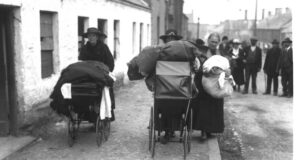
Balbriggan is just 20 miles (30km) north of Dublin city, and as the dust and ashes settled on the seaside town, the press and their photographers arrived via the city from Ireland, Britain and beyond, taking photographs of burned out streets and forlorn looking refugees. Balbriggan was even described as the ‘Irish Louvain’ in the Manchester Guardian, referring to the Belgian city destroyed by the Germans in 1914.[4]
A secret inquiry was undertaken by the British authorities in Dublin Castle, which concluded that, ‘it is quite clear that the burning was organised and countenanced by officers in charge’. Mark Sturgis a senior civil servant in Dublin Castle, thought that the Crown forces should have confined themselves to ‘dignified shooting’. The destruction of property had, he thought, ‘spoilt the whole thing’.
Still, he concluded, ‘worse things can happen than the firing up of a sink like Balbriggan’.[5]
Autumn 1920 – A Season of Terror
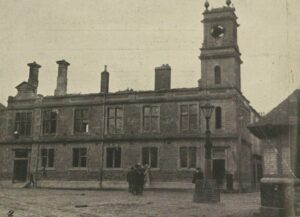
The ‘sack of Balbriggan’, far from being an isolated incident, was part of a concerted series of reprisals by British forces in Ireland, beginning in the summer of 1920 and reaching a crescendo in September and October.
By this stage of the War of Independence, the RIC police had been heavily militarised and reinforced by new recruits known as ‘Black and Tans’ and by a new, distinct paramilitary corps, the Auxiliary Division, composed of ex British Army officers.
According to government figures, 89 police and 11 British Army personnel had been ‘murdered’ in Ireland up to September 1920 by the IRA.[6] Now, according to the government, the RIC, previously ‘prisoners in their barracks’ were hitting back.
The ‘sack of Balbriggan’, far from being an isolated incident, was part of a concerted series of reprisals by British forces in Ireland, in late 1920.
Some of the first large scale reprisals occurred in July 1920, in the towns of Tuam in County Galway and Thurles in County Tipperary, where police burned several buildings, including the town hall at Tuam, in revenge for attacks on their men.
However, a cascade of reprisals occurred within weeks of the Balbriggan affair. In Galway city on September 8, after an RIC driver was shot dead, the police and military burned the Sinn Fein Hall, wrecked a local newspaper office (the Galway Express), shot an IRA suspect, arrested and severely beat many more and imposed a curfew on the town for five weeks.[7]
The new Chief of Police Henry Hugh Tudor, arrived in Galway the following day, and far from upbraiding the police for their actions, told them, ‘this country is ruled by gunmen and they must be put down’. He promised the police machine guns, tanks if required and reinforcement by ‘men who had been in the Army during the War and knew how to shoot to kill’.[8]
The day after the reprisal at Balbriggan, an IRA ambush at Rineen in County Clare killed six RIC officers. In revenge parties of policemen and soldiers raided three local villages, Miltown Malbay, Lahinch and Ennistymon, where they burned sixteen houses and shops and killed five civilians either by bullet and bayonet.[9]
Over September 27-28, elements of the RIC did £50,000 worth of damage to the town of Trim in County Meath, including burning the town hall, after an RIC officer was shot and wounded and similar scenes were repeated in Listowel in Kerry the following day.[10]
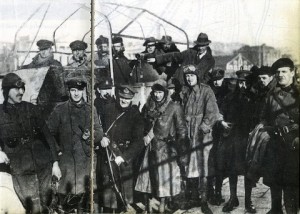
In Mallow, Cork also on September 28, following an IRA raid on the military barracks in which a soldier was killed and the guerrillas seized thirty rifles and a machine gun, along with over 4,000 rounds of ammunition, it was the Army – the 17th Lancers – that went on the rampage.
They burned the town hall, the local creamery and houses and shot and wounded two local men. [11]
Finally, on the last day of September, another RIC District Inspector, Brady, was killed by a shotgun blast in Tubbercurry County Sligo. The police and soldiers who arrived from Sligo, ‘shot up the town’, threw grenades into businesses, burned three shops and two local creameries, while shouting ‘come out Sinn Fein!’. [12]
The creameries, mainstay of the rural economy, were a particular target of the reprisals of late 1920, by the end of the year forty two had been burnt around the country.
This was alongside hundreds of arrests, beatings and shooting of suspects. By the end of the year, according to the Irish Bulletin –admittedly a biased source as the organ of Irish Republican news – Crown forces had killed some 200 civilians in Ireland, not counting those IRA members who had been killed or executed.[13]
‘Spontaneous outbursts?’
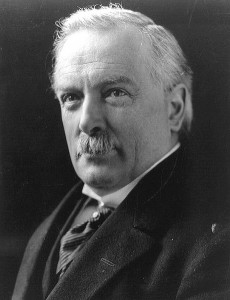
The British government maintained in public, through the person of the Chief Secretary for Ireland, Hamar Greenwood, that, the police, under terrible provocation had ‘lost control of themselves’. ‘These houses were burned and people shot in hot blood of these reprisals’. [14] In other words the reprisals were spontaneous, the work of policemen pushed to breaking point.
But no effort was made to punish the perpetrators. In private both the prime minister Lloyd George, who argued that reprisals had been used in Ireland to ‘check crime ‘from time immemorial’ and should go on’[15] and Winston Churchill who ‘saw very little harm’ in shooting ‘Sinn Fein’ suspects seem to have approved of the actions of Crown Forces in Ireland.
Furthermore, the modus operandi of the reprisals, in particular the ubiquitous targeting of the town hall and creamery, seems to suggest some central direction.
The British government maintained that reprisals were spontaneous retaliation of the police, but evidence points towards a policy of collective punishment.
Reprisals would only escalate over the winter of 1920, including the ‘siege of Tralee’ on November 1-9, the shooting of a football crowd at Croke Park in Dublin, killing 14 on ‘Bloody Sunday’ November 21, and burning out of the commercial centre of Cork city by a company of Auxiliaries on December 11.
It was only in the rarest of cases that the IRA could mount a defence of towns and villages from police reprisals – the relative success of Sean MacEoin’s Longford IRA unit at defending Ballinalee from a reprisal party on November 3 became so well known precisely because it was so rare.
So in this sense, the government perhaps considered such actions as had happened at Balbriggan and elsewhere effective, in that they showed the IRA’s supporters that the guerrillas could not protect them. As Mark Sturgis put it, ‘surely the people who say, “stop the murders before all our homes go up in smoke” must increase?’[16]
By almost every other measure, however, the British reprisals of late 1920 were surely wholly counter-productive. On the one hand, the government maintained that its forces were upholding the law against a ‘conspiracy’ of unrepresentative gunmen, ‘who form no part of the business or productive class or Ireland’ and who wished to intimidate ‘by torch and revolver’ the moderate majority of Irish citizens. [17]
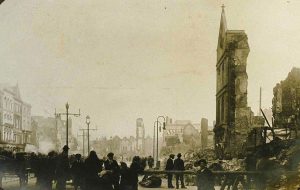
But on the other hand, the government acquiesced in a reprisal policy that not only brazenly broke the law itself, but also, by randomly destroying property, hit out indiscriminately precisely at the business and farming sectors that the government claimed were its natural supporters.
It was, in a sense, a back-handed acknowledgment that the Sinn Fein movement enjoyed widespread support and that the population as a whole needed to be terrorised. But it also naturally alienated the very sectors of Irish society that the British government should have been trying to court, for its policy of walking Irish demands back from full independence to limited self government on a partitioned island.
Just as, if not more important, however, was the impact of reprisals in Ireland in the press and public opinion in Britain itself and further afield.
Elsewhere in the British Empire, such counter-insurgency measures went largely unremarked upon. In Iraq for instance, which British troops occupied in the First World War and which saw an uprising against them in 1920, it was considered standard practice for artillery to ‘strafe’ a village suspected of harbouring insurgents, ‘sometimes they get the wrong village, which matters little!’ one soldier wrote. Following the bombardment, he reported, infantry ‘proceed to wipe out all who are foolish enough to wait for us’ and to burn the village.[18]
But Iraq was far away, its inhabitants culturally distinct and spoke a different, unfamiliar language. Ireland was right next door to Britain, its inhabitants were white, English speaking and its population were not colonial subjects, but citizens of the United Kingdom.
Losing the propaganda war
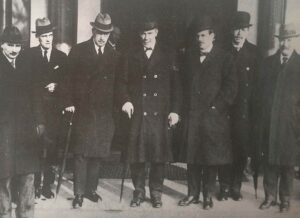
The British press, including even some of the right wing press such as the Daily Mail, were appalled by the policy of collective reprisals in Ireland, which undermined the rule of law in Britain itself and tarnished its reputation abroad.
As the Mail protested, ‘half the world is coming to feel that our government is condoning vendetta and lawless reprisals’ in Ireland. The left wing Daily News wrote that reprisals were ‘the method by which Great Britain is waging war upon Ireland’.[19]
In Parliament the Labour MP Arthur Henderson condemned the reprisals of September and October and called for an independent inquiry. When this was not forthcoming a delegation of British Labour MPs travelled to Ireland to conduct their own investigation.
Reprisals in Ireland led to a storm of protest in the press in Britain and to inquiries by the Labour Party and the American Commission. Both damned British policy in Ireland.
Their report, published in December 1920, catalogued a series of burning, killing, looting and intimidation by Crown forces in Ireland and concluded,
‘so great has been the provocation of the forces of the Crown that eighty per cent of Irish men and women now regard the shooting of policeman and the throwing of bombs at lorries with the same philosophical resignation that Lloyd George displays to arson pillage and the shooting of civilians in the presence of their wives and children.’[20]
It lamented that ‘the honour of our [British] people has been gravely compromised and called on the British people to ‘raise their voices against the rule of force in Ireland’.[21]
The American Commission on Conditions in Ireland, who delivered an interim report early in 1921, similarly damned the conduct of Crown forces. It concluded that
‘in spite of …the British Imperial Government ceaselessly attempting to terrorize the people and to paralyse the economic and social life of the country, the Republican government appears to be holding its own and establishing its right to be considered the only working government in Ireland’. [22]
They and others, including for instance, the Women’s International for Peace and Freedom League, who visited Ireland in October 1920, called for the withdrawal of the British ‘army of occupation and the opening of negotiations with the self proclaimed Irish Republican authorities.
In other words, the reprisals of late 1920 and the media coverage they inspired, helped to legitimise internationally the Irish Republican line that they, in the form of the First Dail, were the legitimate, popular authority in Ireland and war was being waged against them by the British ‘Army of occupation’.
The Government might maintain that they were fighting only a ‘criminal conspiracy’ of Irish extremists, ‘encouraged by the speeches of the Labour leaders and [Liberal] Asquith’, but by 1921 very few outside of the most hard-line Conservatives in Britain still accepted this proposition.[23]
It was a defeat, in part self-inflicted, that was perhaps more significant than any reverse that the IRA could inflict on British forces in Ireland.
References
[1] Ross O’Mahony, The Sack of Balbriggan, in David Fitzpatrick, ed., Terror in Ireland, Lilliput Press, Dublin 2012. p.63-64
[2] Labour Commission Report, December 1920, online here
[3] O’Mahony The Sack of Balbriggan, Terror in Ireland p.65, Some other accounts put the number of homes destroyed as high as 50.
[4] Cited in Douglas Porch, Counterinsurgency Exposing the Myths of a New Way of War, p.111. The comparison between Balbriggan and Belgium is much overblown. In Louvain, or Louven as it is known today, the Germans destroyed over 2,000 buildings, including the university and its library and killed hundreds of civilians in August 1914.
[5] Michael Hopkinson, The Irish War of Independence, Gill & MacMillan, Dublin 2004, p.80
[6] Figures were cited by Chief Secretary Hamar Greenwood in Parliament, reported in The Irish Times, February 22, 1921
[7] Conor McNamara, War and revolution in the West of Ireland, Galway 1919-1922, Irish Academic Press, Newbridge, 2018, p.144-145
[8] D.M Leeson, The Black and Tans, British Police and Auxiliaries in the Irish War of Independence, Oxford University Press, 2011 p.46
[9] Padraig Og Ó Ruairc, Blood on The Banner, The Republican Struggle in Clare 1919-1923, Mercier, 2008, pp.167-171; O’Malley, On Another Man’s Wound, pp.77-87
[10] Leeson, p.75
[11] Dorothy Macardle The Irish Republic, Corgi 1968 p.358, Ernie O’Malley One Another Man’s Wound, p 213-217
[12] Charles Townshend, The Republic, The Fight For Irish Independence, Penguin, 2013, p.165-166
[13] Cited in Dominic Price, We Bled Together, Michael Collins The Squad and the Dublin Brigade, Kindle edition Loc2720. For the record the IRA Roll of Honour the Last Post, pp99-113, listed 252 Volunteers killed in 1920.
[14] Irish Times February 22, 1921. According to Richard Abbott’s Police casualties in Ireland, 179 police were killed in Ireland in 1920. By the end of that year some 63 British Army soldiers had also been killed by the IRA according to this list https://www.cairogang.com/soldiers-killed/list-1921.html
[15] Quoted in Hopkinson, p82
[16] Townshend The Republic, p.165
[17] Quotes from Greenwood in Parliament Irish Times, February 22 1920
[18] Charles Townshend When God Made Hell, the British Invasion of Mesopotamia and the Making of Iraq, 1914-1921, Kindle Edition Loc 5078
[19] Townshend, The Republic, p.168
[20] Labour Commission Report, p.6
[21] Ibid. P.56
[22] Report of the American Commission on Condition in Ireland, p.105. Online here.
[23] Quote is from Greenwood, Irish Times February 22, 1921. Greenwood denounced Asquith and his ‘careless regime’ that had allowed the Rising of 1916 to happen, ‘since which Sinn Fein have never ceased to murder’. Oddly the Prime Minister in the coalition government, Lloyd George was also a Liberal.